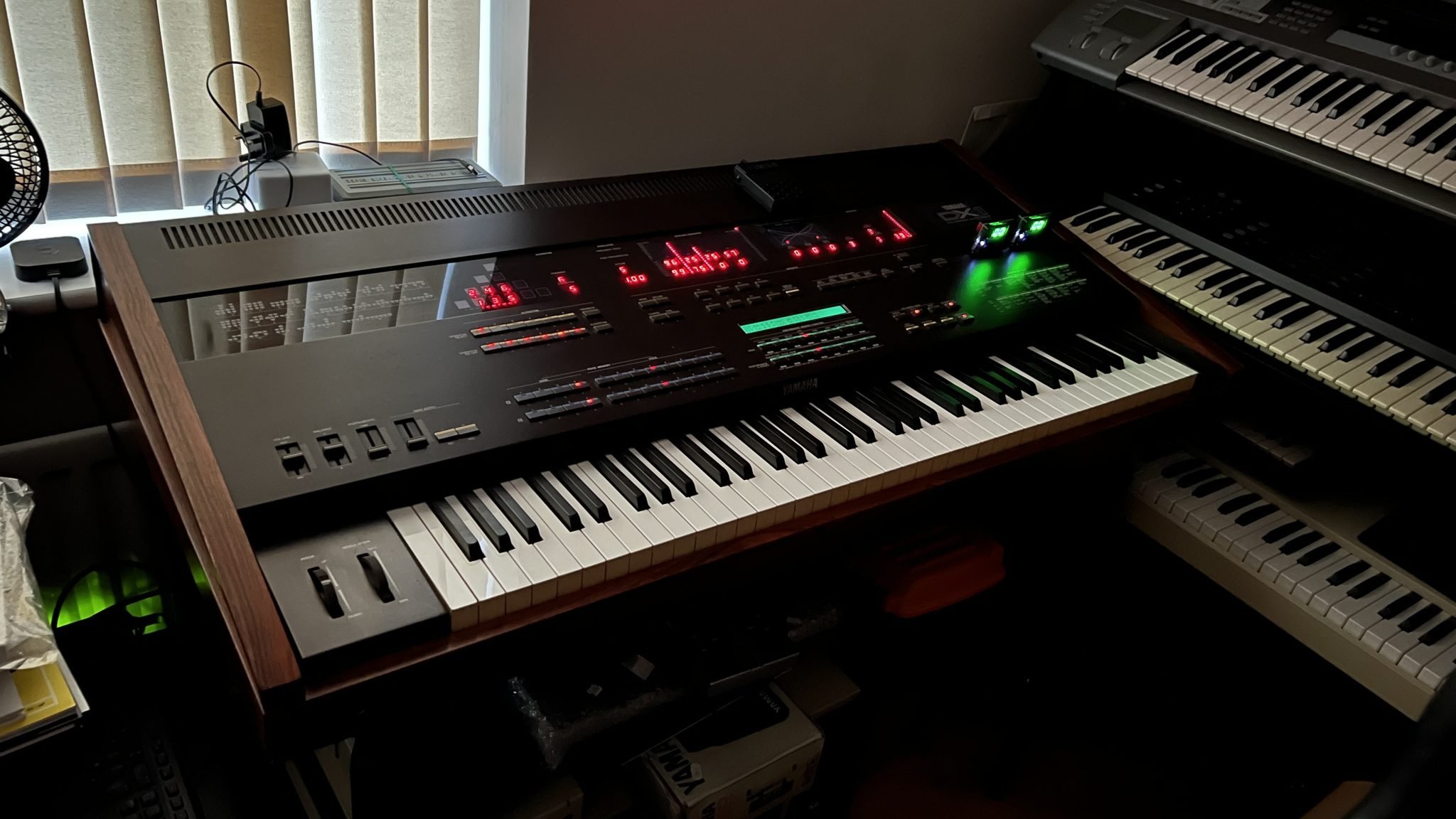Behringer BX-1: What We Know So Far

Behringer’s return to NAMM 2025 was already big news, but no one quite expected the BX-1 to steal the spotlight. While Behringer has built its reputation on recreating classic synthesizers with budget-friendly price tags, the BX-1 isn’t just another one-to-one clone. Instead, it blends elements of one of Yamaha’s most legendary FM synthesizers—the DX1—with features inspired by the CS-80, resulting in a hybrid synth that pushes beyond mere replication. This isn’t just another DX7 reboot. The original Yamaha DX1 was a luxury FM synthesizer that combined the power of two DX7s into one behemoth of an instrument, priced at a staggering $14,000 upon release in the mid-'80s. With only around 140 units ever made, the DX1 became a holy grail synth, sought after by collectors and sound designers alike. Today, they fetch absurd prices—sometimes over $85,000 on the second-hand market. Behringer’s BX-1 aims to bring that same level of sound design power to a wider audience, with some crucial upgrades along the way. At first glance, the BX-1 certainly borrows the imposing look of the DX1, but Behringer has made some bold modifications, including CS-80-inspired analog filters, modern effects, and 32-voice polyphony. Rather than a straight-up DX1 remake, this synth appears to be a fusion of Yamaha’s FM legacy with the expressive depth of classic analog polysynths. It’s an ambitious move—one that could make the BX-1 one of the most interesting hybrid synths Behringer has ever produced.
Disclosure: This post may contain affiliate links. If you buy something through these links, I may earn a commission at no extra cost to you. As an Amazon Associate, I earn from qualifying purchases.
FM Meets Analog: The Sound Engine
At its core, the BX-1 is an FM synthesizer, following in the footsteps of the Yamaha DX series. It features classic FM synthesis with 32 voices of polyphony, a step up from the original DX1’s 16 voices. If Behringer sticks to the standard DX-style architecture, we can expect six-operator FM synthesis, meaning it will be capable of everything from glassy, bell-like tones to deep, evolving pads and punchy bass sounds.
However, what sets the BX-1 apart is Behringer’s addition of analog CS-style filters—something the original DX1 and DX7 completely lacked. One of the biggest criticisms of classic Yamaha FM synths was their reliance on digital envelopes and static-sounding filters. The BX-1 appears to solve this limitation by incorporating CS-80-inspired analog filters per voice, allowing users to sculpt their FM patches with warm, resonant low-pass filtering and expressive filter sweeps.
This combination of FM synthesis and true analog filtering could make the BX-1 one of the most powerful FM-based synthesizers ever released. While FM synths have always been known for their bright, digital timbres, the ability to run them through fat, analog filters opens up new creative territory. It essentially bridges the gap between two worlds—the precise, metallic textures of FM and the organic, sweeping warmth of analog.
Interface and Hands-On Control
One of the key upgrades over the original DX1 is the interface. The DX1 had a more hands-on approach compared to the DX7, with dedicated parameter access, but it was still limited compared to analog subtractive synths. Behringer appears to have tackled this issue by including a large front-panel display with easy access to FM parameters, envelopes, and effects, reducing the need for deep menu diving.
In addition to dedicated FM controls, the BX-1 also features knobs and sliders for controlling its analog filter section, a major departure from traditional FM synths. This means that shaping sounds on the BX-1 should feel more immediate and tactile, rather than the sometimes tedious process of programming FM via matrices and menus.
Another notable inclusion is polyphonic aftertouch, a feature that was present on the original DX1 but is still rare in modern synths. This allows for expressive playing, with individual notes responding dynamically to pressure, perfect for lush, evolving pads and cinematic textures. If Behringer implements this well, it could make the BX-1 one of the most playable FM synths available today.
Connectivity, Effects, and Overall Features
Unlike the original DX1, which was limited in terms of built-in effects, the BX-1 is expected to include a full suite of modern digital effects, such as:
Reverb (likely modeled after classic studio reverbs)
Chorus (ideal for thickening FM pads and keys)
Delay (for atmospheric echoes and movement)
These effects should enhance the BX-1’s sound design potential, making it a standalone powerhouse for live performance and studio production.
In terms of connectivity, we can expect:
MIDI I/O (allowing it to integrate with other hardware)
USB-MIDI (for DAW control and software integration)
Stereo audio outputs (hopefully with separate outs for layering sounds)
One thing that remains unclear is whether Behringer will include a sequencer or arpeggiator. Many modern FM synths (such as Elektron’s Digitone) have integrated step sequencing, making it easier to program rhythmic FM patches. Given that Behringer tends to borrow ideas from multiple classic synths, it wouldn’t be surprising if the BX-1 included some form of sequencing or performance tools.
How Much Will the BX-1 Cost?
The original DX1 was an ultra-premium instrument, but Behringer is known for aggressively undercutting vintage synth prices. Early estimates place the BX-1 at just over $1,000, which—if true—would make it one of the most affordable flagship FM synthesizers ever released.
Compared to other FM synths on the market:
Yamaha Montage M8X (Yamaha’s modern FM flagship) costs over $4,000
Elektron Digitone II (an 8-voice FM synth) costs around $800
If Behringer delivers the BX-1 at around the $1,000 mark, it could completely disrupt the FM synth market, especially considering its hybrid architecture and analog filters.
Is the Behringer BX-1 Right for You?
The BX-1 is shaping up to be one of the most exciting FM synths in years, particularly for those who are passionate about FM synthesis and want a deep, hands-on instrument. Sound designers looking for new hybrid textures will likely find its combination of FM and analog filtering appealing, while live performers may appreciate the expressive capabilities of polyphonic aftertouch and real-time control. Producers who love the sound of the DX series but want a more modern workflow will also find plenty to explore.
However, it may not be the ideal choice for everyone. FM synthesis still has a learning curve, which might make it challenging for beginners who are unfamiliar with its intricacies. Analog purists looking for a fully analog signal path may be disappointed, as the core of the BX-1 remains digital. Additionally, those expecting an exact replica of the DX1 might find that Behringer has taken creative liberties, making this more of a reimagining than a strict clone.
With Behringer teasing a potential 2025 release, the BX-1 could be hitting stores sooner than later, unlike some of their more drawn-out product launches. If they stick to their promise of delivering a high-end FM synth at an affordable price, the BX-1 could easily become one of their most exciting and talked-about releases to date.
Alternatives to the Behringer BX-1
Yamaha Montage M Series
Yamaha's flagship Montage M series combines advanced FM-X synthesis with a sample-based AWM2 engine, providing extensive sound design capabilities. The series includes models like the Montage M6, M7, and M8x, each offering different key configurations and features.
Korg Opsix SE
The Opsix SE is Korg's modern take on FM synthesis, featuring six operators with flexible routing and hands-on controls. It offers a user-friendly interface, making FM synthesis more accessible to musicians seeking both classic and innovative sounds.Elektron Digitone II
Elektron's Digitone II is an 8-voice polyphonic FM synthesizer that integrates a powerful sequencer, allowing for intricate pattern creation. Its streamlined interface and deep modulation options make it suitable for both studio production and live performances.Yamaha Reface DX
The Reface DX is a portable FM synthesizer that emulates the classic DX sound with modern enhancements. It features a 4-operator FM engine, a multi-touch control interface, and built-in speakers, making it suitable for musicians on the go.Korg Volca FM2
An updated version of the original Volca FM, the Volca FM2 offers six-voice polyphony and full compatibility with DX7 patches. Its compact size, built-in sequencer, and affordability make it an excellent choice for those new to FM synthesis.Arturia MiniFreak
Arturia's MiniFreak is a hybrid synthesizer that combines digital oscillators, including FM capabilities, with analog filters. It provides a versatile sound palette, suitable for musicians seeking both digital clarity and analog warmth.
How to Recreate the Behringer BX-1 Sound in Your DAW
Achieving the sound of the Behringer BX-1 in a DAW requires a combination of FM synthesis and analog-style filtering, as the BX-1 itself is a hybrid instrument that merges DX-style FM synthesis with CS-inspired analog filters. While there is no exact VST replica of the BX-1, a layered approach using FM synth plugins alongside analog filter effects can get you remarkably close.
For the FM side of the equation, Dexed is a great starting point. This free, open-source plugin faithfully recreates the Yamaha DX7’s 6-operator FM synthesis, making it one of the most authentic FM emulations available. Its compatibility with original DX7 patches ensures access to a vast library of classic sounds, which can then be sculpted further.
If you're looking for more flexibility and modern refinements, Arturia DX7 V provides the same DX7 foundation but with an enhanced interface, built-in effects, and additional modulation options. This allows for a more hands-on approach to shaping FM tones without getting lost in deep menus. Another strong contender is Native Instruments FM8, which expands upon traditional FM synthesis with an intuitive matrix interface and an extensive range of modulation capabilities, making it a powerful tool for crafting both classic and experimental FM textures.
However, the key difference between these plugins and the BX-1 is the lack of built-in analog-style filtering, which plays a crucial role in shaping the BX-1’s tone. To replicate this hybrid approach, you can process the output of your FM synth plugin through an analog-modeled filter plugin. Options like Arturia Filter MINI, FabFilter Volcano, or Soundtoys FilterFreak can help introduce resonant sweeps, warmth, and movement, emulating the BX-1’s CS-inspired analog filters. If you want even more hands-on control, routing your FM synth through an external analog filter or running it through a hardware effects chain can push the sound even closer to Behringer’s hybrid take on FM synthesis.
Disclosure: This post may contain affiliate links. If you buy something through these links, I may earn a commission at no extra cost to you. As an Amazon Associate, I earn from qualifying purchases.


